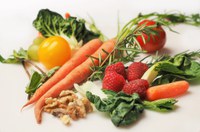Prairie Fare: Are you eating for brain health?
(Click an image below to view a high-resolution image that can be downloaded)
When our kids were young, we read to them every night before bedtime. Some of their books put us to sleep.
Often, I’d find my husband and child sound asleep in a chair with a half-read book.
Our kids liked a book named “Don’t Forget the Oatmeal.” It was a very long book.
I know our kids were delaying their bedtime when they requested this book. Unfortunately, the “oatmeal book” was lost. We hid the book in a closet until they could read it by themselves.
The book told the story of a grocery store trip. The main character was distracted by all the items in the store and forgot the ingredient he wanted to buy.
The book named dozens (maybe thousands?) of foods in the grocery store, hence its epic length.
Do you ever forget things at the grocery store? We all get distracted. Maybe you arrive in a room in your home on a mission to find something. Then you cannot recall what you were going to retrieve.
Perhaps I’m the only one who does this. I don’t think I’m alone, though.
If you misplace items such as glasses, keys or your phone, should you be worried that something is going on with your brain?
We all want to maintain our brains throughout our lifetime. We have several lifestyle factors that can help our brain, including nutrition and physical activity.
Can your brain get a little rusty? In some ways, our body is somewhat like a car.
Oxidative damage in the human body is similar to how a car rusts. Oxidative damage occurs when harmful molecules called free radicals cause damage to the body’s cells. The free radicals for a car are the salt, sand and other elements that damage a car.
Just as you can treat some rust spots on a car, some damage to your body’s cells can be fixed. However, some rust is too advanced. When your cells get damaged by too many free radicals, health problems such as heart disease, diabetes and cancer may occur.
Your brain also can be attacked by free radicals, which may lead to decreases in memory and thinking and, in advanced cases, even dementia.
Are you fueling your body and brain with antioxidant-rich foods? We, in the nutrition field, encourage eating a variety of food. Unfortunately, many people do not eat enough of the foods that are especially protective for our bodies and brains.
A recent study showed that just 10% of adults eat enough fruits and vegetables. Adults should aim to consume 2 to 3 cups of vegetables and 1.5 to 2 cups of fruit daily.
Foods rich in antioxidants, especially fruits and vegetables, may help slow or prevent oxidative damage. Several vitamins have antioxidant properties, especially vitamins C, E and beta-carotene (which your body converts to vitamin A). These vitamins work to remove free radicals from the body.
Fruits and vegetables are not the only foods that help fuel our body and brain health. Here are some examples of brain-healthy nutrients and food sources.
Vitamin C is found in citrus fruits, broccoli, brussels sprouts, strawberries and cantaloupe.
Vitamin E is found in vegetable oils, such as corn, canola, sunflower, soybean and olive oil. Nuts and some fortified cereals also provide this nutrient.
Vitamin B-12 is found in animal products such as meat, fish, poultry, eggs and milk.
Folate is a B vitamin found in leafy greens, dry edible beans and fortified cereals.
Beta-carotene is found in sweet potatoes, carrots, kale, spinach and winter squash. Beta-carotene is converted to vitamin A in our body.
Omega-3 fatty acids also are good for our brains. Salmon, trout and tuna are good sources. Flaxseed, canola oil, soybean oil and walnuts are sources of another type of omega-3 fat.
Nutrition and fitness go together in helping keep our brains active. Go for a walk after a healthful meal to exercise your brain and muscles.
This easy breakfast or brunch dish includes folate- and beta-carotene-rich spinach and vitamin B12-rich eggs. Enjoy some strawberries and cantaloupe as a nutrition-rich accompaniment.
Crustless Spinach Quiche
5 large eggs, beaten
1 (10-ounce) box frozen spinach, thawed and drained
6 ounces of low-fat (1%) cottage cheese
4 ounces feta cheese
½ ounce shredded Swiss cheese
2 tablespoons margarine
1/2 teaspoon nutmeg
Preheat the oven to 350 F. Spray a quiche pan or 10-inch pie pan with cooking spray. In a large bowl, combine all the ingredients except the spinach. Stir in spinach. Pour into a pan and bake for 35 to 45 minutes until slightly browned on top.
Makes eight servings. Each serving has 160 calories, 11 grams (g) fat, 12 g protein, 4 g carbohydrate, 1 g fiber and 340 milligrams sodium.
Julie Garden-Robinson, Ph.D., R.D., L.R.D., is a North Dakota State University Extension food and nutrition specialist and professor in the Department of Health, Nutrition and Exercise Sciences. Follow her on Twitter @jgardenrobinson)
NDSU Agriculture Communication – March 23, 2023
Source: Julie Garden-Robinson, 701-231-7187, julie.garden-robinson@ndsu.edu
Editor: Elizabeth Cronin, 701-231-7881, elizabeth.cronin@ndsu.edu




